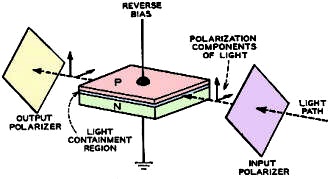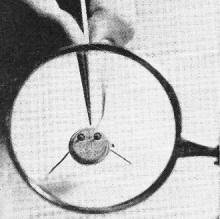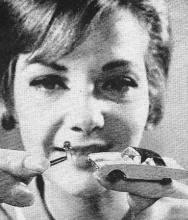News Briefs
|
|
In 1967 when this set of News Briefs was published in Radio-Electronics magazine, the use of semiconductors in laser light applications was the domain of government, corporate, and university research laboratories. The device only modulated the beam. It did not generate the beam, although as seen below infrared laser diodes were already in the works. Also wowing the readership was a pinhead-size gallium arsenide (GaAs) transmitter which could generate frequency modulated (FM) signals in the 60 MHz to 2.5 GHz range. The "highest ever" starting salary for engineering students in that year was a whopping $166/week, or $8,632/year. That is the equivalent of $80,674 in 2024 money. By comparison, $16/hour fast food workers in California are pulling in $33,280/year, and qualify for many welfare benefits and healthcare. A really interesting item is how a group of British high school radio enthusiasts routinely tracked Russian satellite orbits to reverse engineer the point of launch, and on occasion discovered new ground bases, like the Plesetsk Cosmodrome in Mirny. New Briefs: 11/1957 | 8/1958 | 11/1959 | 2/1960 | 4/1960 | 8/1960 | 3/1961 | 5/1961 | 6/1961 | 12/1961 | 3/1963 | 4/1963 | 8/1963 | 9/1963 | 8/1964 | 12/1964 | 1/1967 | 3/1967 | 4/1967 | 9/1967 | 4/1968 News BriefsThe modulation of a laser beam, for transmitting information, has required much power and hasn't been possible with much bandwidth in the past. Now, Bell Telephone Laboratories scientists have discovered three ways to impress broadband signals on laser beams, using modulating powers of less than 1 watt. The gallium-phosphide diode is one system (see sketch). Reverse bias is applied to the diode, and an incoming light wave is polarized and focused on the diode's pn junction region. The two polarization components of the light wave then travel at different velocities along the plane of the pn junction. They emerge from the junction out of phase with each other. This is equivalent to phase modulation. Finally, the phase-modulated components are passed through an output polarizer, where PM is converted to AM. The gallium-phosphide diode can modulate light because of the linear electro-optic effect-which takes place in the diode pn junction when a reverse bias is applied. The semiconductor requires only 1.5 mW of power per MHz of modulation bandwidth. The second device is a lithium tantalate electro-optic modulator. It uses a coded sequence of high-speed electrical pulses or digits to modulate an equally fast, uncoded train of light pulses from a helium-neon laser. The lithium tantalate modulator is most useful in pulse-code modulation of digital information; it can handle up to 896 million bits per second. The third device is an infrared modulator, consisting of a thin rod of gallium-doped yttrium iron garnet. Infrared light waves traveling through the crystal are continuously modulated when the direction of the crystal's internal magnetic field is varied. With power of only 0.1 watt, this device has a bandwidth of 200 MHz. Electronics is getting to sound like science fiction - remember "The Incredible Shrinking Man"? Latest near-disappearance: an FM transmitter (range 60 MHz-2.5 GHz) slightly larger than a pinhead. The device-shown in the photo dwarfed by its mounting holder - is made of gallium arsenide. The application of relatively high voltage to the semiconductor, causes Gunn effect and microwave emission. Field-effect principle is then used to modulate the microwave carrier. The new device has three terminals, is effectively a junction diode with a modulation gate added. The tiny transmitter was developed by a team of RCA scientists, who envision hand-held microwave transmitters that would open up a new range of personal-communication possibilities. Engineers Still Earn Most Students who are graduated from engineering colleges this year will be paid an average starting salary of $166 per week. That's the highest beginning wage ever paid to a new diploma holder, and tops all other graduates in business and industry. These estimates are compiled annually in a study of industry hiring practices by Frank S. Endicott, director of placement at Northwestern University. Since 1947 - when Endicott's surveys started - engineering graduates have consistently received top starting salaries. A new combination of radar and laser techniques could decrease traffic accidents. A solid-state injection laser (see photo), in this case a semiconductor that emits coherent light, is being considered as the heart of a new form of automobile collision-avoidance system. Infrared light from the laser would be bounced off the car ahead - as in a radar system - and would warn if a collision was impending. Warning would be given with lights or audible signals; if the driver failed to take corrective action, brakes would be applied automatically. The laser device also has possibilities as fog penetrator, burglar alarm, and private communications system. As the solid-state laser can be modulated, it could be used to aim a narrow beam of infrared "signals" at a receiver. intercepting the message would be nearly impossible without knowing which way the transmitter was aimed. Devices available from the developer (RCA) include a 50-watt injection-laser diode array about the size of a pencil eraser, a 2-watt unit smaller than a kernel of corn, and IR light emitter close to the size of the bead of a pin. Teenage Students Discover Soviet Missile Base As a man-made satellite moves across the sky, its radio transmissions change pitch slightly with respect to a fixed receiving station - due to Doppler effect. Using this principle, a group of English school students tracked Russian space launches. Working backward from the orbit records they accumulated, and using a computer, they pinpointed the location of a new missile base unknown to the West until now. The students have a surplus WW II military radio, a 40-foot antenna, and an ordinary globe of the world. Since 1962, the group of 100 boys and girls - aged 15 to 18 - have made 1,700 radio observations, recording the orbits of 75 USSR satellites. In some cases, they have recorded a missile launch before the Soviets have announced it. All data gathered by the students is sent to the British space agency. It has been known that the Russians have been using space-launch bases at Kapustin Yar and Tyuratam for several years. Site found by the British students is at Plesetsk, 400 miles north of Moscow and the USSR's first far-north space base.
Posted March 7, 2024 |
|



